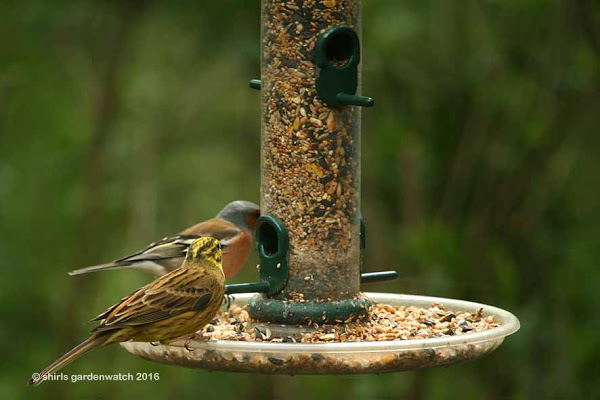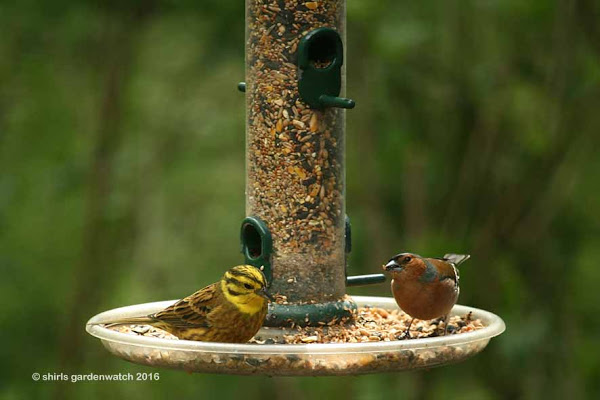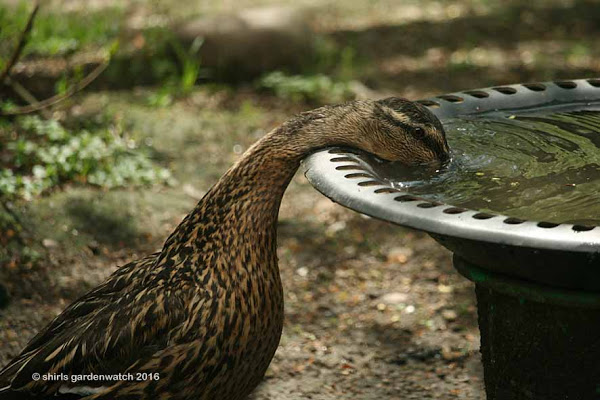Today’s ‘do something for wildlife’ was a very quick and easy job. It will reduce the spilling of bird seed (mess and waste) and smaller birds will appreciate the extra space for landing, perching and feeding. Less trampling of plants below the feeder will be great too 🙂
Being Father’s Day here in the UK, it was a family day and no gardenwatching until late evening. The feeders had been busy in our absence. When refilling them, I remembered I had purchased a small tray that screws into the base of my seed feeders and it was still in the packet.
Tray fitted, I enjoyed a peaceful hour at the end of a busy day watching for birds using it. None came, but it was after 8pm on a dark wet evening. A female Blackbird, a Dunnock, a female House Sparrow and two Woodpigeons were the only visitors I could see and they were feeding on the ground.
It was on our last visit to see the Ospreys at SWT Loch of the Lowes (live cam on nest) that I spotted this smaller size of feeder tray. I liked that size! One of my favourite birds to see there was using it too – the Yellowhammer.
On this occasion, seeing as he was with us and he gifted me a new zoom lens for my birthday, I handed my camera over to my husband and suggested he tried it out. As well as a great female Mallard duck capture, he took images of the feeder tray that had caught my eye. Seeing as it’s Father’s Day, his photo captures are the ones I am posting tonight 🙂
Having previously used one of these trays, I found two things I’d like to pass on. The first is that overtightening of the butterfly screw (supplied with the tray) can break the threads. I’ve done that.
Woodpigeons hogging the feeder is the other! Yep, once they discover they can land on the larger tray, the smaller birds can’t get a look in! The feeder becomes like a swing at a children’s playground when two make it on board – back and forth it goes as they demolish and scatter seed.
Time will tell if a Woodpigeon can land on the smaller tray (I will report back). I really hope they don’t. They’ve got plenty of other feeding areas they can manage. In past winters, with heavy snow, I found many species of birds feeding at the same time using the tray. I’d like to see if the same will happen with a smaller tray in the summer months 🙂
This post was published by Shirley for shirls gardenwatch in June 2016.



I love the little saucer underneath your bird feeder. Did that come with the feeder or did you put it on afterwards? The duck drinking picture is delightful. I enjoyed reading your blog today very much.
Stella, Welcome back, thanks for popping by with your comment 🙂
No, the feeder saucer was bought separately. I bought this particular one from an RSPB shop for a RSPB feeder. Online it shows a large, medium and small size. It is possible some trays are universal. I don’t know though. I loved that duck capture too.
Thank-you, it’s been a serious challenge posting every day in June but I’ve enjoyed it. This is not the norm for me. I see you are new to blogging – wishing you much fun with it. I’ll be over to browse later. Yay, tonight I won't be writing late and posting just before midnight! I’ve got today’s post sorted and scheduled to post later… ah 🙂
While the saucer does help to save some of the seed scattered (here) by Starlings I found it took a lot of cleaning in wet weather to clean up a soggy mess of seed in rainy periods.
Hello again John, ah yes, I do remember that from before when I had the larger saucer. Update on the Woodpigeon landing on the saucer tonight – it can manage it!! Only one at a time though, so that’s still an improvement 😉
I found like you the wood pigeons used the trays to land on and empty the feeders. I have now purchased cages for the feeders and use plastic pot saucers, the size of the cages,with holes drilled in for drainage to catch the spillage which I swap with a spare when necessary placing it on the ground for W.P etc to clear up.